How to write a custom scan handling class for specplot#
Sometimes, it will be obvious that a certain scan macro never generates any plot images, or that the default handling creates a plot that is a poor representation of the data, such as the hklscan where only one of the the axes hkl is scanned. To pick the scanned axis for plotting, it is necessary to prepare custom handling and replace the default handling.
Overview#
It is possible to add in additional handling by writing a Python module.
This module creates a subclass of the standard handling, such as
LinePlotter,
MeshPlotter, or their superclass
ImageMaker.
The support is added to the macro selection class
Selector with code such as in the brief
example described below: Change the plot title text in ascan macros:
selector = spec2nexus.specplot.Selector()
selector.add('ascan', Custom_Ascan)
spec2nexus.specplot_gallery.main()
Data Model#
The data to be plotted is kept in an appropriate subclass of
PlotDataStructure in attributes show in the next
table. The data model is an adaptation of the NeXus NXdata base class. [1]
attribute |
description |
|---|---|
|
name of the dependent data (y axis or image) to be plotted |
|
list of names of the independent axes [2] |
|
dictionary with the data, indexed by name (\(Q\) & \(R\)) |
Steps#
In all cases, custom handling of a specific SPEC macro name is provided by
creating a subclass of ImageMaker and defining one
or more of its methods. In the simplest case, certain settings may be changed
by calling spec2nexus.specplot.ImageMaker.configure() with the custom
values. Examples of further customization are provided below, such as when the
data to be plotted is stored outside of the SPEC data file. This is common for
images from area detectors.
It may also be necessary to create a subclass of
PlotDataStructure to gather the data to be
plotted or override the default spec2nexus.specplot.ImageMaker.plottable()
method. An example of this is shown with the
MeshPlotter and associated
MeshStructure classes.
Examples#
A few examples of custom macro handling are provided, some simple, some complex. In each example, decisions have been made about where to provide the desired features.
Change the plot title text in ascan macros#
The SPEC ascan macro is a workhorse and records the scan of a positioner and
the measurement of data in a counter. Since this macro name ends with “scan”,
the default selection in specplot images this data using the
LinePlotter class. Here is a plot of the default
handling of data from the ascan macro:
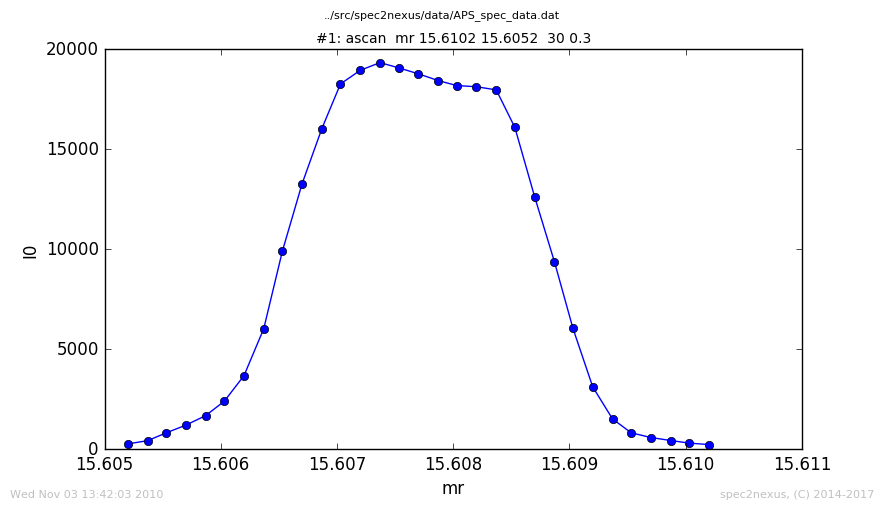
Standard plot of data from ascan macro#
We will show how to change the plot title as a means to illustrate how to customize the handling for a scan macro.
We write Custom_Ascan which is a subclass of
LinePlotter. The get_plot_data method is
written (overrides the default method) to gain access to the place where we can
introduce the change. The change is made by the call to the configure
method (defined in the superclass). Here’s the code:
ascan.py example
1#!/usr/bin/env python
2
3'''
4Plot all scans that used the SPEC `ascan` macro, showing only the scan number (not full scan command)
5
6This is a simple example of how to customize the scan macro handling.
7There are many more ways to add complexity.
8'''
9
10import spec2nexus.specplot
11import spec2nexus.specplot_gallery
12
13
14class Custom_Ascan(spec2nexus.specplot.LinePlotter):
15 '''simple customization'''
16
17 def retrieve_plot_data(self):
18 '''substitute with the data&time the plot was created'''
19 import datetime
20 spec2nexus.specplot.LinePlotter.retrieve_plot_data(self)
21 self.set_plot_subtitle(str(datetime.datetime.now()))
22
23
24def main():
25 selector = spec2nexus.specplot.Selector()
26 selector.add('ascan', Custom_Ascan)
27 spec2nexus.specplot_gallery.main()
28
29
30if __name__ == '__main__':
31 main()
32
33# -----------------------------------------------------------------------------
34# :author: Pete R. Jemian
35# :email: prjemian@gmail.com
36# :copyright: (c) 2014-2025, Pete R. Jemian
37#
38# Distributed under the terms of the Creative Commons Attribution 4.0 International Public License.
39#
40# The full license is in the file LICENSE, distributed with this software.
41# -----------------------------------------------------------------------------
See the changed title:
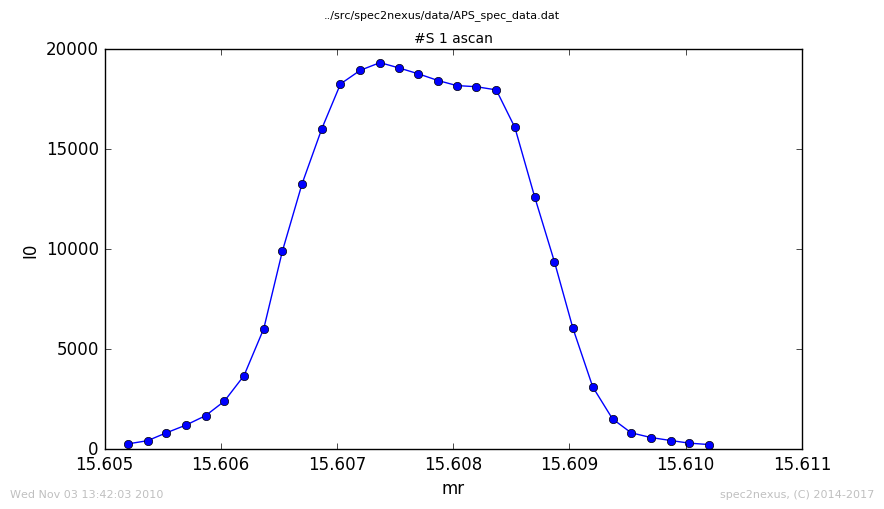
Customized plot of data from ascan macro#
Make the y-axis log scale#
A very simple customization can make the Y axis to be logarithmic scale. (This customization is planned for an added feature [3] in a future relase of the spec2nexus package.) We present two examples.
modify handling of a2scan#
One user wants all the a2scan images to be plotted with a logarithmic scale on the Y axis. Here’s the code:
custom_a2scan_gallery.py example
1#!/usr/bin/env python
2
3'''
4Customization for specplot_gallery: plot a2scan with log(y) axis
5
6This program changes the plotting for all scans that used the *a2scan* SPEC macro.
7The Y axis of these plots will be plotted as logarithmic if all the data values are
8greater than zero. Otherwise, the Y axis scale will be linear.
9'''
10
11import spec2nexus.specplot
12import spec2nexus.specplot_gallery
13
14class Custom_a2scan_Plotter(spec2nexus.specplot.LinePlotter):
15 '''plot `a2scan` y axis as log if possible'''
16
17 def retrieve_plot_data(self):
18 '''plot the vertical axis on log scale'''
19 spec2nexus.specplot.LinePlotter.retrieve_plot_data(self)
20
21 choose_log_scale = False
22
23 if self.signal in self.data: # log(y) if all data positive
24 choose_log_scale = min(self.data[self.signal]) > 0
25
26 self.set_y_log(choose_log_scale)
27
28
29def main():
30 selector = spec2nexus.specplot.Selector()
31 selector.add('a2scan', Custom_a2scan_Plotter)
32 spec2nexus.specplot_gallery.main()
33
34
35if __name__ == '__main__':
36 # debugging_setup()
37 main()
38
39'''
40Instructions:
41
42Save this file in a directory you can write and call it from your cron tasks.
43
44Note that in cron entries, you cannot rely on shell environment variables to
45be defined. Best to spell things out completely. For example, if your $HOME
46directory is `/home/user` and you have these directories:
47
48* `/home/user/bin`: various custom executables you use
49* `/home/user/www/specplots`: a directory you access with a web browser for your plots
50* `/home/user/spec/data`: a directory with your SPEC data files
51
52then save this file to `/home/user/bin/custom_a2scan_gallery.py` and make it executable
53(using `chmod +x ./home/user/bin/custom_a2scan_gallery.py`).
54
55Edit your list of cron tasks using `crontab -e` and add this (possibly
56replacing a call to `specplot_gallery` with this call `custom_a2scan_gallery.py`)::
57
58 # every five minutes (generates no output from outer script)
59 0-59/5 * * * * /home/user/bin/custom_a2scan_gallery.py -d /home/user/www/specplots /home/user/spec/data 2>&1 >> /home/user/www/specplots/log_cron.txt
60
61Any output from this periodic task will be recorded in the file
62`/home/user/www/specplots/log_cron.txt`. This file can be reviewed
63for diagnostics or troubleshooting.
64'''
custom uascan#
The APS USAXS instrument uses a custom scan macro called uascan for routine
step scans. Since this macro name ends with “scan”, the default selection in
specplot images this data using the LinePlotter
class. Here is a plot of the default handling of data from the uascan macro:
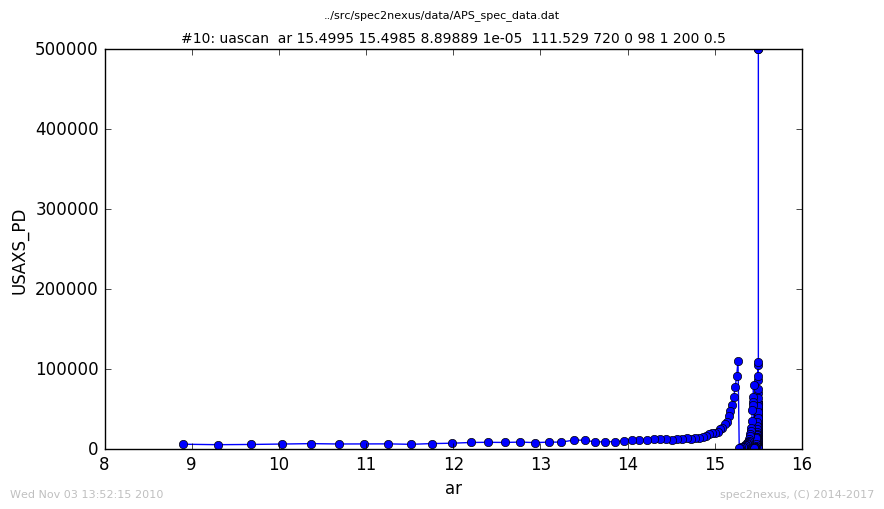
USAXS uascan, handled as LinePlotter#
The can be changed by making the y axis log scale. To do this, a custom
version of LinePlotter is created as
Custom_Ascan. The get_plot_data method is written (overrides
the default method) to make the y axis log-scale by calling the
configure method (defined in the superclass). Here’s the code:
usaxs_uascan.py example
1#!/usr/bin/env python
2
3"""
4Plot data from the USAXS uascan macro
5
6.. autosummary::
7
8 ~UAscan_Plotter
9
10"""
11
12import spec2nexus.specplot
13import spec2nexus.specplot_gallery
14
15
16class UAscan_Plotter(spec2nexus.specplot.LinePlotter):
17 """Customized `uascan` handling"""
18
19 def retrieve_plot_data(self):
20 """plot the vertical axis on log scale"""
21 spec2nexus.specplot.LinePlotter.retrieve_plot_data(self)
22
23 if self.signal in self.data:
24 # can't plot negative Y on log scale
25 # Alternative to raising NotPlottable would be
26 # to remove any data where Y <= 0
27 if min(self.data[self.signal]) <= 0:
28 msg = "cannot plot Y<0: " + str(self.scan)
29 raise spec2nexus.specplot.NotPlottable(msg)
30
31 # in the uascan, a name for the sample is given in `self.scan.comments[0]`
32 self.set_y_log(True)
33 self.set_plot_subtitle(
34 "#%s uascan: %s" % (str(self.scan.scanNum), self.scan.comments[0])
35 )
36
37
38def debugging_setup():
39 import os, sys
40 import shutil
41 import ascan
42
43 selector = spec2nexus.specplot.Selector()
44 selector.add("ascan", ascan.Custom_Ascan) # just for the demo
45 path = "__usaxs__"
46 shutil.rmtree(path, ignore_errors=True)
47 os.mkdir(path)
48 sys.argv.append("-d")
49 sys.argv.append(path)
50 sys.argv.append(
51 os.path.join("..", "src", "spec2nexus", "data", "APS_spec_data.dat")
52 )
53
54
55def main():
56 selector = spec2nexus.specplot.Selector()
57 selector.add("uascan", UAscan_Plotter)
58 spec2nexus.specplot_gallery.main()
59
60
61if __name__ == "__main__":
62 # debugging_setup()
63 main()
64
65# -----------------------------------------------------------------------------
66# :author: Pete R. Jemian
67# :email: prjemian@gmail.com
68# :copyright: (c) 2014-2025, Pete R. Jemian
69#
70# Distributed under the terms of the Creative Commons Attribution 4.0 International Public License.
71#
72# The full license is in the file LICENSE, distributed with this software.
73# -----------------------------------------------------------------------------
Note that in the uascan, a name for the sample provided by the user is given in self.scan.comments[0]. The plot title is changed to include this and the scan number. The customized plot has a logarithmic y axis:
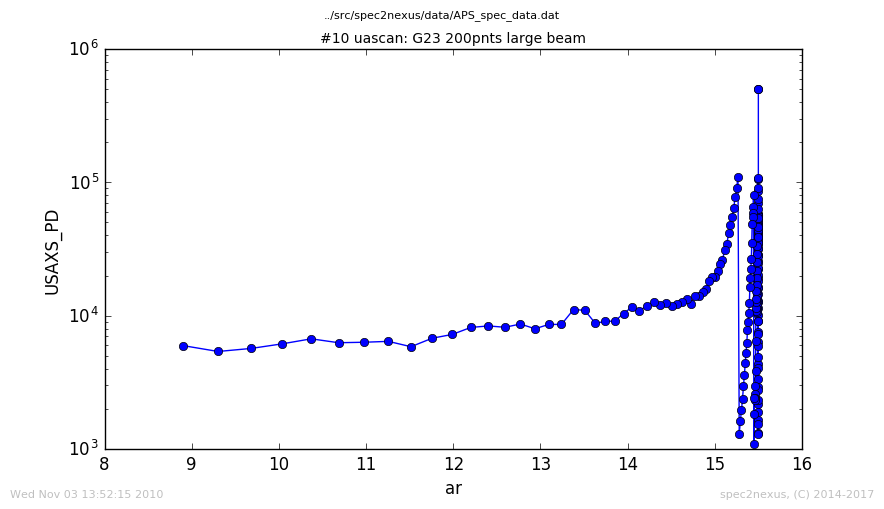
USAXS uascan, with logarithmic y axis#
The most informative view of this data is when the raw data are reduced to \(I(Q)\) and viewed on a log-log plot, but that process is beyond this simple example. See the example Get xy data from HDF5 file below.
SPEC’s hklscan macro#
The SPEC hklscan macro appears in a SPEC data file due to either a hscan, kscan, or lscan. In each of these one of the hkl vectors is scanned while the other two remain constant.
The normal handling of the ascan macro plots the last data column against the first. This works for data collected with the hscan. For kscan or lscan macros, the h axis is still plotted by default since it is in the first column.
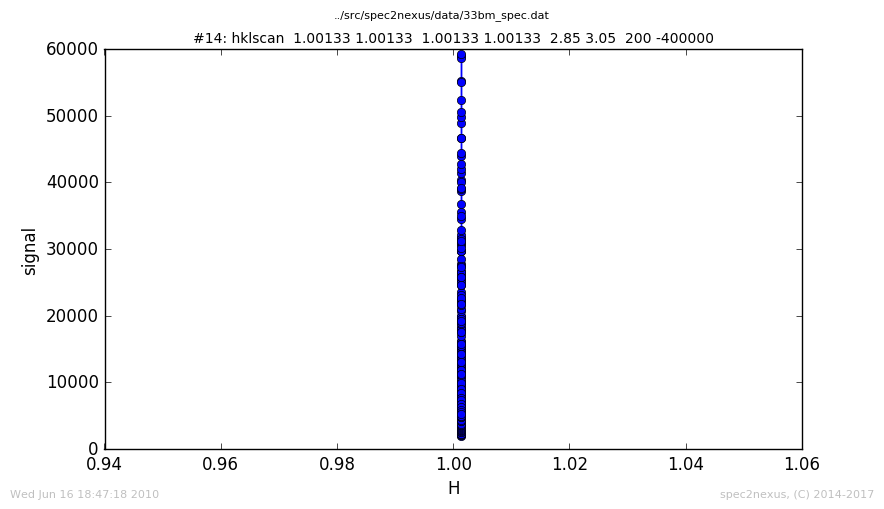
SPEC hklscan (lscan, in this case), plotted against the (default) first axis H#
To display the scanned axis, it is necessary to examine the data in a custom
subclass of LinePlotter. The
HKLScanPlotter subclass, provided with specplot,
defines the get_plot_data() method determines the scanned axis, setting it
by name:
plot.axes = [axis,]
self.scan.column_first = axis
Then, the standard plot handling used by LinePlotter uses this information to make the plot.
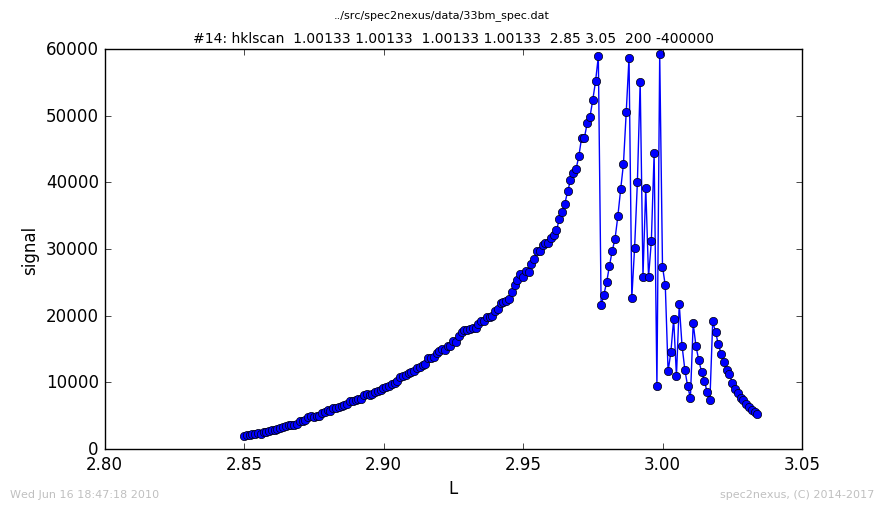
SPEC hklscan (lscan), plotted against L#
Get xy data from HDF5 file#
One example of complexity is when SPEC has been used to direct data collection but the data is not stored in the SPEC data file. The SPEC data file scan must provide some indication about where the collected scan data has been stored.
custom usaxs_flyscan#
The USAXS instrument at APS has a FlyScan macro that commands the instrument to collect data continuously over the desired \(Q\) range. The data is written to a NeXus HDF5 data file. Later, a data reduction process converts the arrays of raw data to one-dimensional \(I(Q)\) profiles. The best representation of this reduced data is on a log-log plot to reveal the many decades of both \(I\) and \(Q\) covered by the measurement.
With the default handling by LinePlotter, no plot
can be generated since the data is given in a separate HDF5 file. That file
is read with the custom handling of the usaxs_flyscan.py demo:
usaxs_flyscan.py example
1#!/usr/bin/env python
2
3"""
4Plot data from the USAXS FlyScan macro.
5
6.. autosummary::
7
8 ~read_reduced_fly_scan_file
9 ~retrieve_flyScanData
10 ~USAXS_FlyScan_Structure
11 ~USAXS_FlyScan_Plotter
12
13"""
14
15import h5py
16import numpy
17import pathlib
18
19import spec2nexus.specplot
20import spec2nexus.specplot_gallery
21
22# $URL: https://subversion.xray.aps.anl.gov/small_angle/USAXS/livedata/specplot.py $
23REDUCED_FLY_SCAN_BINS = 250 # the default
24PLOT_AXES = ["Q", "R"]
25
26
27# methods picked (& modified) from the USAXS livedata project
28def read_reduced_fly_scan_file(hdf5_file_name):
29 """
30 Read any and all reduced data from the HDF5 file, return in a dictionary.
31
32 dictionary = {
33 'full': (dictionary keys: Q, R, R_max, ar, fwhm, centroid)
34 '250': (dictionary keys: Q, R, dR)
35 '5000': (dictionary keys: Q, R, dR)
36 }
37 """
38
39 reduced = {}
40 with h5py.File(str(hdf5_file_name), "r") as hdf:
41 entry = hdf["/entry"]
42 for key in entry.keys():
43 if key.startswith("flyScan_reduced_"):
44 nxdata = entry[key]
45 d = {}
46 for dsname in PLOT_AXES:
47 if dsname in nxdata:
48 value = nxdata[dsname]
49 if value.size == 1:
50 d[dsname] = float(value[0])
51 else:
52 d[dsname] = numpy.array(value)
53 reduced[key[len("flyScan_reduced_") :]] = d
54 return reduced
55
56
57def retrieve_flyScanData(scan):
58 """Retrieve reduced, rebinned data from USAXS Fly Scans."""
59 comment = scan.comments[2]
60 key_string = "FlyScan file name = "
61 index = comment.find(key_string) + len(key_string)
62
63 hdf_file_name = comment[index:-1]
64 path = pathlib.Path(scan.header.parent.fileName).parent
65 abs_file = (path / hdf_file_name).absolute()
66
67 plotData = {}
68 if abs_file.exists():
69 reduced = read_reduced_fly_scan_file(abs_file)
70 s_num_bins = str(REDUCED_FLY_SCAN_BINS)
71
72 choice = reduced.get(s_num_bins) or reduced.get("full")
73
74 if choice is not None:
75 plotData = {axis: choice[axis] for axis in PLOT_AXES}
76
77 return plotData
78
79
80class USAXS_FlyScan_Plotter(spec2nexus.specplot.LinePlotter):
81 """
82 Customize `FlyScan` handling, plot :math:`log(I)` *vs.* :math:`log(Q)`.
83
84 The USAXS FlyScan data is stored in a NeXus HDF5 file in a subdirectory
85 below the SPEC data file. This code uses existing code from the
86 USAXS instrument to read that file.
87 """
88
89 def retrieve_plot_data(self):
90 """Retrieve reduced data from the FlyScan's HDF5 file."""
91 # get the data from the HDF5 file
92 fly_data = retrieve_flyScanData(self.scan)
93
94 if len(fly_data) != 2:
95 raise spec2nexus.specplot.NoDataToPlot(str(self.scan))
96
97 self.signal = "R"
98 self.axes = ["Q"]
99 self.data = fly_data
100
101 # customize the plot just a bit
102 # sample name as given by the user?
103 subtitle = "#" + str(self.scan.scanNum)
104 subtitle += " FlyScan: " + self.scan.comments[0]
105 self.set_plot_subtitle(subtitle)
106 self.set_x_log(True)
107 self.set_y_log(True)
108 self.set_x_title(r"$|\vec{Q}|, 1/\AA$")
109 self.set_y_title(r"USAXS $R(|\vec{Q}|)$, a.u.")
110
111 def plottable(self):
112 """
113 Can this data be plotted as expected?
114 """
115 if self.signal in self.data:
116 signal = self.data[self.signal]
117 if signal is not None and len(signal) > 0 and len(self.axes) == 1:
118 if len(signal) == len(self.data[self.axes[0]]):
119 return True
120 return False
121
122
123def debugging_setup():
124 import sys
125 import shutil
126
127 path = pathlib.Path("..") / "src"
128 sys.path.insert(0, str(path))
129 path = "__usaxs__"
130 shutil.rmtree(path, ignore_errors=True)
131 pathlib.os.mkdir(path)
132 sys.argv.append("-d")
133 sys.argv.append(path)
134 data_file = path / "spec2nexus" / "data" / "02_03_setup.dat"
135 sys.argv.append(str(data_file.absolute()))
136
137
138def main():
139 selector = spec2nexus.specplot.Selector()
140 selector.add("FlyScan", USAXS_FlyScan_Plotter)
141 spec2nexus.specplot_gallery.main()
142
143
144if __name__ == "__main__":
145 # debugging_setup()
146 main()
147
148# -----------------------------------------------------------------------------
149# :author: Pete R. Jemian
150# :email: prjemian@gmail.com
151# :copyright: (c) 2014-2025, Pete R. Jemian
152#
153# Distributed under the terms of the Creative Commons Attribution 4.0 International Public License.
154#
155# The full license is in the file LICENSE, distributed with this software.
156# -----------------------------------------------------------------------------
The data is then rendered in a customized log-log plot of \(I(Q)\):
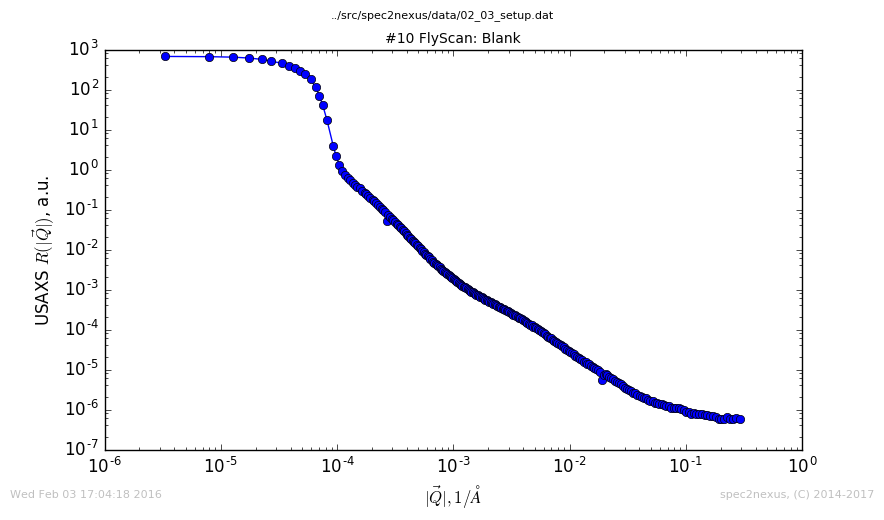
USAXS FlyScan, handled by USAXS_FlyScan_Plotter#
The USAXS_FlyScan_Plotter() class provides custom methods for
retrieve_plot_data() and plottable() which will be called from
spec2nexus.specplot.ImageMaker.plot_scan().
Method USAXS_FlyScan_Plotter.plottable() returns a boolean value if the data
can be plotted.
Method USAXS_FlyScan_Plotter.retrieve_plot_data() gets the data from the
scan by calling retrieve_flyScanData() with the scan object. Then the
method customizes the plot details.
Function retrieve_flyScanData(scan) gets the name of the NeXus/HDF5 file
from the scan and reads the HDF5 file, returning either the reduced data with
the number of points (as described in REDUCED_FLY_SCAN_BINS) or the full
data set.
Usage#
When a custom scan macro handler is written and installed using code similar to the custom ascan handling above:
def main():
selector = spec2nexus.specplot.Selector()
selector.add('ascan', Custom_Ascan)
spec2nexus.specplot_gallery.main()
if __name__ == '__main__':
main()
then the command line arugment handling from spec2nexus.specplot_gallery.main()
can be accessed from the command line for help and usage information.
Usage:
user@localhost ~/.../spec2nexus/demo $ ./ascan.py
usage: ascan.py [-h] [-r] [-d DIR] paths [paths ...]
ascan.py: error: too few arguments
Help:
user@localhost ~/.../spec2nexus/demo $ ./ascan.py -h
usage: ascan.py [-h] [-r] [-d DIR] paths [paths ...]
read a list of SPEC data files (or directories) and plot images of all scans
positional arguments:
paths SPEC data file name(s) or directory(s) with SPEC data
files
optional arguments:
-h, --help show this help message and exit
-r sort images from each data file in reverse chronolgical
order
-d DIR, --dir DIR base directory for output (default:/home/prjemian/Documen
ts/eclipse/spec2nexus/demo)